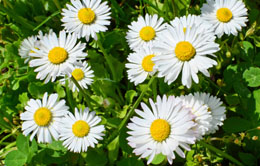Chamomile can be grown as a herb as well as an annual plant bearing flowers. They are easy to grow and add amazing beauty to a garden.

Chamomile is an annual herb. It has pretty delicate daisy-like white or yellow flowers, that grow amongst its scented green foliage. For those who enjoy fresh chamomile tea, growing chamomile in their own garden will always ensure fresh supply of the herb.
Types of Chamomile
Chamomile can be grown indoors in boxes or containers, and outdoors in beds or sidewalks. Non-flowering, small and compact chamomile apple scented plants are ideal for lawns, sidewalks, and pathways. There are different single-petaled varieties, though a third hybrid double flowered chamomile has also been developed.
Roman Chamomile
This is a perennial cold-hardy variety that is used medicinally, and has dense carpeting. It is low-growing, just 30 cm tall, with green leaves that are feathery in texture and having a ripe apple scent. The flowers of Roman chamomile are white in color and single-petaled.
German Chamomile
This perennial plant is an upright growing annual, with fine ferny leaves and white daisy single-petal flowers. Like Roman chamomile, it is used medicinally.
Pineapple Weed Chamomile
This is an annual plant, with greenish-yellow single petal flowers and pineapple scented foliage. This variety is used for yielding a golden-brown dye.
Double Flowered Chamomile
This variety is used commercially in Europe. It is propagated by divisions. A flowerless variety is also available, and is used for planting along stones and sidewalks.
Growing Chamomile in a Garden
This task is not difficult, one just needs to know how to go about it. Following are a few things one needs to keep in mind while growing chamomile.
Seeds
Chamomile are easy to grow using seeds. Every year they will sprout from the ground where they are sown, saving you the trouble of re-sowing. The soil must be well prepared. It must be light, manured, and porous. The seeds must be evenly spread and covered with a very thin layer of light soil, as the seeds are very small and require light to germinate. Sprinkle just enough water to moisten them. The seedlings will sprout within a couple of weeks and will be ready for transplantation at a four-leaf stage.
Saplings
Saplings should be healthy and free from disease and wilting. If you are buying them, make sure there are no flowers growing on them, as early flowering will damage the development of the plant. The sapling should be spaced between 30 cm and 60 cm apart, to allow them the space to grow to their full size. They should be planted in a sunny patch and well-drained soil. However, it is advisable to sow the seeds, where you wish to grow the plant, as their roots get damage while transplanting.
Caring for Chamomile
The plants should be watered regularly and fed on organic liquid fertilizer, every four to six weeks. Plants that do not receive full sunlight are susceptible to mildew. Pinching back the earlier growth will make the plant bushier. During periods of heavy rainfall and strong winds, tall varieties should be provided with support. The soil should be kept moist and mulched.
Harvest
The flowers should be harvested early morning and when in full bloom. They can be used either in the fresh or dried form. For drying, spread them out on a clean tray and leave it in a cool, ventilated and dry place, and store in a sterile air-tight jar.
Chamomile is used for its medicinal properties. It is excellent for treating allergies, burns, fevers, insomnia, and indigestion. Its oil is used in bathing and cosmetic products, as it has anti-allergic properties.
A day started with a chamomile-flavored cup of tea, and a garden full of chamomile flowers to stroll around, now that's what we can call heaven.






 Chamomile is an annual herb. It has pretty delicate daisy-like white or yellow flowers, that grow amongst its scented green foliage. For those who enjoy fresh chamomile tea, growing chamomile in their own garden will always ensure fresh supply of the herb.
Chamomile is an annual herb. It has pretty delicate daisy-like white or yellow flowers, that grow amongst its scented green foliage. For those who enjoy fresh chamomile tea, growing chamomile in their own garden will always ensure fresh supply of the herb.